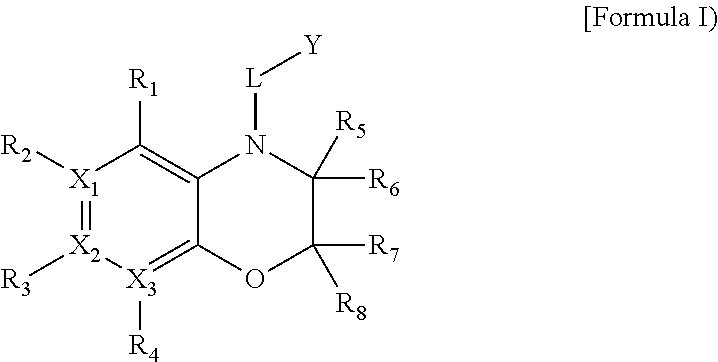Heterocyclic derivatives
a heterocyclic derivative and derivative technology, applied in the field of new heterocyclic derivative compounds, can solve the problems of drug insufficient activity, gout is a very dangerous factor, and the drug is not easy to metabolize, so as to reduce the dosage, reduce the risk of gout, and reduce the effect of administration tim
- Summary
- Abstract
- Description
- Claims
- Application Information
AI Technical Summary
Benefits of technology
Problems solved by technology
Method used
Image
Examples
example 1
Synthesis of (3,5-dibromo-4-hydroxy-phenyl)-(2,3-dihydro-pyrido[2,3-b][1,4]oxazin-1-yl)-methanone (compound 1)
a) Synthesis of 3-amino-pyridin-2-ol
[0190]In a 500 ml flask, 3-nitro-pyridin-2-ol (1 g, 71.4 mmol) was dissolved in methanol (200 ml), and then added 10% palladium on active carbon (100 mg, 10 w / w %). The reaction mixture was stirred for 3 hours under hydrogen atmosphere at room temperature. The resulting reaction solution was filtered on celite and then evaporated under reduced pressure to obtain white solid (800 mg, quantitative yield).
[0191]1H-NMR (CD3OD, 300 MHz); δ=6.78-6.73 (m, 2H), 6.23 (t, J=6.5 Hz, 1H).
[0192]MS (ESI); 111.1 (M++1).
b) Synthesis of 1H-pyrido[2,3-b][1,4]oxazin-2-one
[0193]In a 20 ml flask equipped with a reflux apparatus, 3-amino-pyridin-2-ol (300 mg, 2.72 mmol) was dissolved in acetonitrile (27 ml). To the reaction solution was added chloroacetyl chloride (0.24 ml, 3.0 mmol) dropwise at room temperature, followed by Potassium carbonate (940 mg, 6.80 mm...
example 2
Synthesis of (3,5-dibromo-4-methoxy-phenyl)-(2,3-dihydro-pyrido[4,3-b][1,4]oxazin-4-yl)-methanone (compound 2)
a) Synthesis of 3-amino-pyridin-4-ol
[0202]In a 1000 ml flask, 3-nitro-pyridin-4-ol (11.6 g, 82.8 mmol) was dissolved in methanol (800 ml), and then added 10% palladium on active carbon (1.2 g, 10 w / w %). The reaction mixture was stirred for 3 hours under hydrogen atmosphere at room temperature. The resulting reaction solution was filtered on celite and then evaporated under reduced pressure to obtain white solid (9.4 g, quantitative yield).
[0203]1H-NMR (DMSO-d, 300 MHz); δ=7.34 (dd, J=6.5 Hz, 1.5 Hz, 1H), 7.13 (d, J=1.5 Hz, 1H), 5.99 (d, J=6.5 Hz, 1H), 4.53 (s, 2H), 3.90-2.90 (br s, 1H).
[0204]MS (ESI); 111.1 (M++1).
b) Synthesis of 4H-pyrido[4,3-b][1,4]oxazin-3-one
[0205]In a 500 ml flask equipped with a reflux apparatus, 3-amino-pyridin-4-ol (7.8 g, 71 mmol) was dissolved in N,N-dimethyl formamide (350 ml). To the reaction solution was added chloroacetyl chloride (6.2 ml, 78 ...
example 3
Synthesis of (3,5-dibromo-4-hydroxy-phenyl)-(2,3-dihydro-pyrido[4,3-b][1,4]oxazin-4-yl)-methanone bromic acid salt (compound 3)
[0214]To a 20 ml flask, (3,5-dibromo-4-methoxy-phenyl)-(2,3-dihydro-pyrido[4,3-b][1,4]oxazin-4-yl)-methanone (310 mg, 0.72 mmol) obtained in the example 2 was dissolved in dichloromethane, and then cooled to 0□. 1.0M Boron tribromide dissolved in dichloromethane (4.3 ml, 4.3 mmol) was added thereto and then stirred at 0□ for 10 hours. The resulting solid by addition of n-hexane was filtered and collected, and purified by recrystallizing from methanol to obtain the target compound 3 as white solid (130 mg, 43%).
[0215]1H-NMR (DMSO-d6, 300 MHz); δ=9.02 (s, 1H), 8.45 (d, 1H, J=6.5 Hz), 7.82 (s, 2H), 7.53 (d, 1H, J=6.5 Hz), 4.57 (m, 2H), 3.99 (m, 2H).
[0216]MS (ESI); 412.8 (M++1).
[0217]Elementary Analysis: C14H10Br2N2O3.HBr C, 34.47; H, 2.26; N, 5.63
PUM
| Property | Measurement | Unit |
|---|---|---|
| concentration | aaaaa | aaaaa |
| concentration | aaaaa | aaaaa |
| pKa | aaaaa | aaaaa |
Abstract
Description
Claims
Application Information
 Login to View More
Login to View More - R&D
- Intellectual Property
- Life Sciences
- Materials
- Tech Scout
- Unparalleled Data Quality
- Higher Quality Content
- 60% Fewer Hallucinations
Browse by: Latest US Patents, China's latest patents, Technical Efficacy Thesaurus, Application Domain, Technology Topic, Popular Technical Reports.
© 2025 PatSnap. All rights reserved.Legal|Privacy policy|Modern Slavery Act Transparency Statement|Sitemap|About US| Contact US: help@patsnap.com



